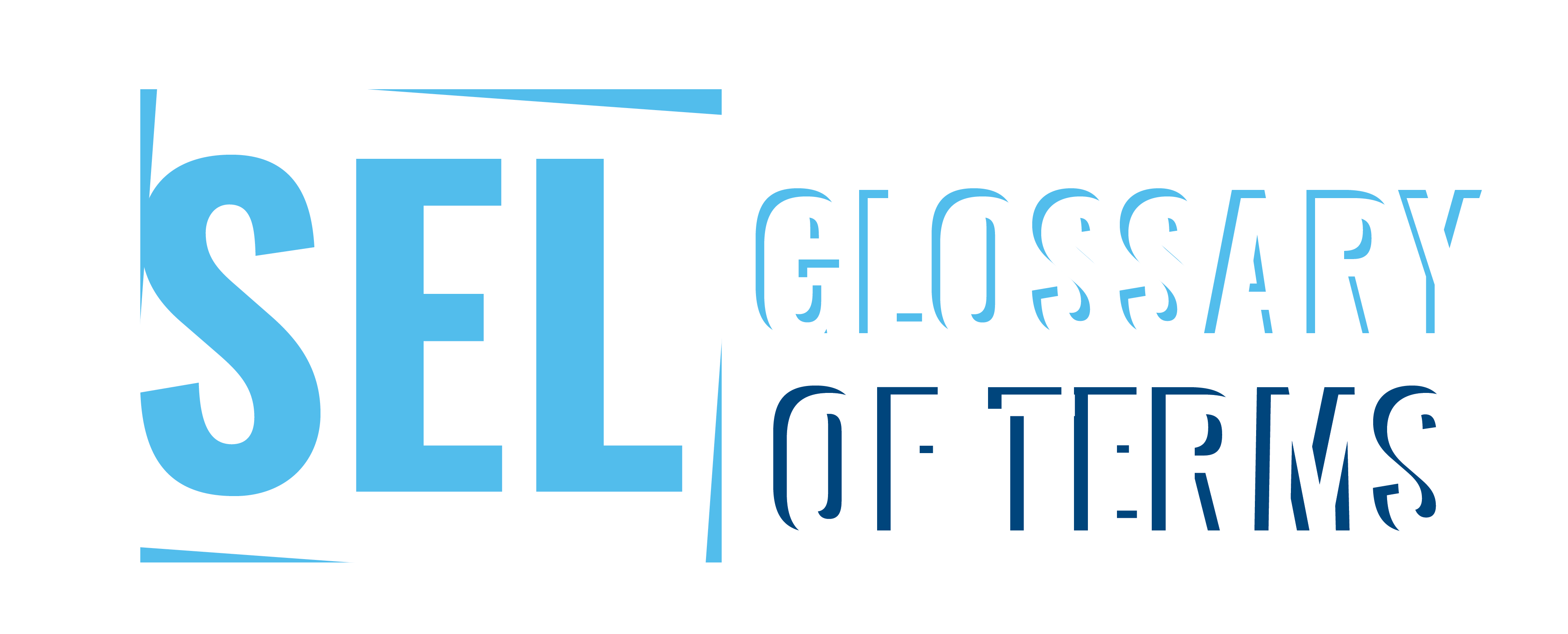
Social and emotional learning; social-emotional learning (SEL) - The process through which children and adults acquire and effectively apply the knowledge, attitudes, and skills necessary to understand and manage emotions, set and achieve positive goals, feel and show empathy for others, establish and maintain positive relationships, and make responsible decisions. [1]
Emotional literacy - It made up of the ability to understand your emotions, the ability to listen to others and empathize with their emotions, and the ability to express emotions productively. To be emotionally literate is to be able to handle emotions in a way that improves an individuals personal power and improves the quality of life around them. Emotional literacy improves relationships, creates loving possibilities between people, makes co-operative work possible, and facilitates the feeling of community. [2]
Character education - A learning process that enables students and adults in a school community to understand, care about and act on core ethical values such as respect, justice, civic virtue and citizenship, and responsibility for self and others. [3]
Mindset - A set of assumptions, methods, or notions held by one or more people or groups of people. [4] Students who hold learning mindsets are more motivated to take on challenging work, persist in the face of setbacks, and achieve at higher levels. [4a]
Interpersonal skills - The ability to interact with people through effective listening and communication. [5]
Intrapersonal skills - the internal abilities and behaviors that help you manage emotions, cope with challenges, and learn new information. [6]
Whole-child education - Policies, practices, and relationships that ensure each child, in each school, in each community, is healthy, safe, engaged, supported, and challenged. It engages all stakeholders—educators, families, policymakers, and community members. [7]
Child development - The biological, psychological and emotional changes that occur in human beings between birth and the conclusion of adolescence. The main 3 stages of life include early childhood, middle childhood, and adolescence. [8]
Wellness - This refers to diverse and interconnected dimensions of physical, mental, and social well-being that extend beyond the traditional definition of health. It includes choices and activities aimed at achieving physical vitality, mental readiness, social satisfaction, a sense of accomplishment, and personal fulfillment. [9]
Mental health - The emotional, psychological, and social well-being of an individual. It affects how human beings think, feel, and act. It also helps determine how individuals handle stress, relate to others, and make choices. Mental health is important at every stage of life, from childhood and adolescence through adulthood. [10]
Self-management - The ability to regulate one’s emotions, thoughts, and behaviors effectively in different situations. This includes managing stress, controlling impulses, motivating oneself, and setting and working toward achieving personal and academic goals. [11]
Self-awareness - The ability to accurately recognize one’s emotions and thoughts and their influence on behavior. This includes accurately assessing one’s strengths and limitations and possessing a well-grounded sense of confidence and optimism. [12]
Social awareness - The ability to take the perspective of and empathize with others from diverse backgrounds and cultures, to understand social and ethical norms for behavior, and to recognize family, school, and community resources and supports. [13]
Relationship skills - The ability to establish and maintain healthy and rewarding relationships with diverse individuals and groups. This includes communicating clearly, listening actively, cooperating, resisting inappropriate social pressure, negotiating conflict constructively, and seeking and offering help when needed. [14]
Responsible decision-making - The ability to make constructive and respectful choices about personal behavior and social interactions based on consideration of ethical standards, safety concerns, social norms, the realistic evaluation of consequences of various actions, and the well-being of self and others. [15]
Peer pressure (social pressure) - A feeling that one must do the same things as other people of one's age and social group in order to be liked or respected by them. [16]
Diversity - This refers to the attributes that people use to confirm themselves with respect to others, “that person is different from me.” These attributes include demographic factors (such as race, gender, and age) as well as values and cultural norms. [17]
Empathy - The capacity to understand or feel what another person is experiencing from within their frame of reference, that is, the capacity to place oneself in another's position. [18]
Sympathy - The perception, understanding, and reaction to the distress or need of another life form. [19]
Social justice - The relation of balance between individuals and society measured by comparing distribution of wealth differences, from personal liberties to fair privilege opportunities. [20]
Collaboration - The process of two or more people, entities or organizations working together to complete a task or achieve a goal. [21]
Critical thinking - is a widely accepted educational goal. Its definition is contested, but the competing definitions can be understood as differing conceptions of the same basic concept: careful thinking directed to a goal. [22]
Communication skills - This is defined as the transmission of a message that involves the shared understanding between the contexts in which the communication takes place. Communication skills involve listening and speaking as well as reading and writing [23]
Social competence - The condition of possessing the social, emotional, and intellectual skills and behaviors needed to succeed as a member of society. [24]
Social norms - are regarded as collective representations of acceptable group conduct as well as individual perceptions of particular group conduct. [25]
Independence - A personality trait in which a person consistently prefers to act on his/her own thoughts and feelings than take in the views of others. [26]
Autonomy - the capacity to make an informed, un-coerced decision. Autonomy in childhood and adolescence is when one strives to gain a sense of oneself as a separate, self-governing individual. [27]
Competence (as in social and emotional) - This is the ability to interact with others, regulate one's own emotions and behavior, solve problems, and communicate effectively. Children who are socially and emotionally competent have healthy self-esteem. [28]
Compassion - Motivates people to go out of their way to help the physical, mental, or emotional pains of another and themselves. Compassion is often regarded as having sensitivity, which is an emotional aspect to suffering. Though, when based on cerebral notions such as fairness, justice, and interdependence, it may be considered rational in nature and its application understood as an activity also based on sound judgment. [29]
Confidence - A belief in oneself, the conviction that one has the ability to meet life's challenges and to succeed—and the willingness to act accordingly. Being confident requires a realistic sense of one’s capabilities and feeling secure in that knowledge. [30]
Self-efficacy - This refers to an individual's belief in his or her capacity to execute behaviors necessary to produce specific performance attainments. [31]
Values - Values are basic and fundamental beliefs that guide or motivate attitudes or actions. They help us to determine what is important to us. Values describe the personal qualities we choose to embody to guide our actions; the sort of person we want to be; the manner in which we treat ourselves and others, and our interaction with the world around us. [32]
Morals - A person's standards of behavior or beliefs concerning what is and is not acceptable for them to do. [33]
Character Development - The development of conscience, moral concepts, religious values, and social attitudes in the child. [34]
References
1. CASEL
2. Steiner, C. with Perry, P. (1997) Achieving Emotional Literacy. London: Bloomsbury.
3. US Department of Education
4. "MINDSET - meaning in the Cambridge English Dictionary"
5. Jagran Josh
6. Healthline
7. ASCD
8. Children, National Research Council (US) Panel to Review the Status of Basic Research on School-Age; Collins, W. Andrew (1984). Introduction. National Academies Press (US).
9. Huseyin Naci; John P. A. Ioannidis (June 11, 2015). "Evaluation of Wellness Determinants and Interventions by Citizen Scientists"
10. MentalHealth.gov
11, 12, 13, 14, 15. CASEL
16. Merriam Webster
17. Ferris, G.; Frink, D.; Galang, M.C. (1993). "Diversity in the Workplace: The Human Resources Management Challenges". Human Resource Planning. 16 (1): 42.
18. Bellet, Paul S.; Michael J. Maloney (1991). "The importance of empathy as an interviewing skill in medicine". JAMA. 226 (13): 1831–1832.
19. Tear, J; Michalska, KJ (2010). "Neurodevelopmental changes in the circuits underlying empathy and sympathy from childhood to adulthood". Developmental Science. 13 (6): 886–899
20. Aristotle, The Politics (ca 350 BC) & Clark, Mary T. (2015). "Augustine on Justice," a Chapter in Augustine and Social Justice. Lexington Books. pp. 3–10. ISBN 978-1-4985-0918-3.
21. Marinez-Moyano, I. J. Exploring the Dynamics of Collaboration in Interorganizational Settings, Ch. 4, p. 83, in Schuman (Editor). Creating a Culture of Collaboration. Jossey-bass, 2006. ISBN 0-7879-8116-8.
22. Stanford Encyclopedia of Philosophy
23. Saunders and Mills, 1999
24. Encyclopedia of Children's Health
25. Lapinski, M. K.; Rimal, R. N. (2005). "An explication of social norms". Communication Theory. 15 (2): 127–147.
26. Psychology Wiki
27. Berk, Laura (2013). Child Development (9 ed.). Pearson
29. Sherlyn Jimenez, see article on Compassion, The Encyclopedia of Positive Psychology, Volume I, Editor: Shane Lopez, Wiley-Blackwell
30. Psychology Today
31. Bandura, 1977, 1986, 1997
32. Ethics Sage
33. Oxford Languages
